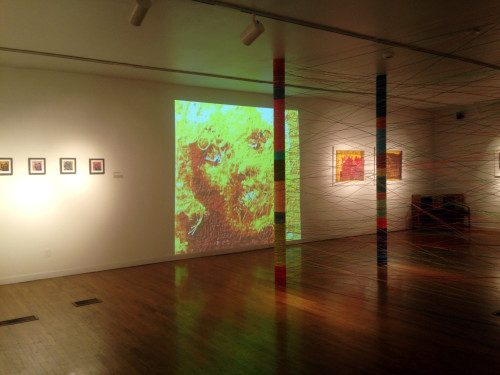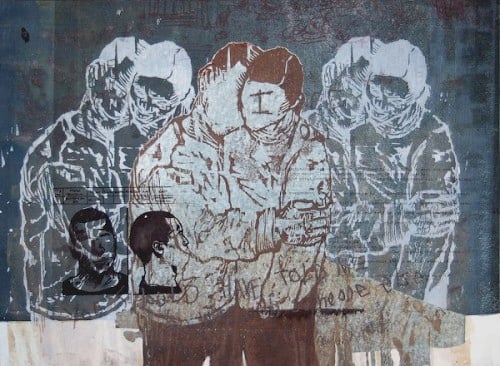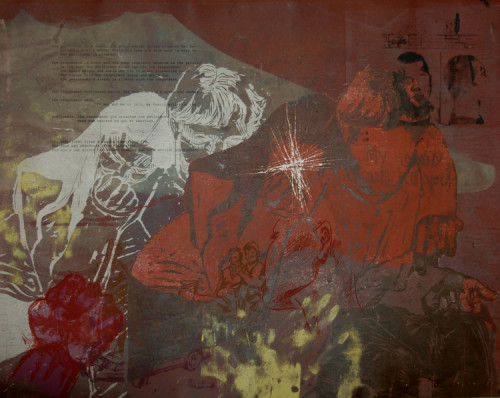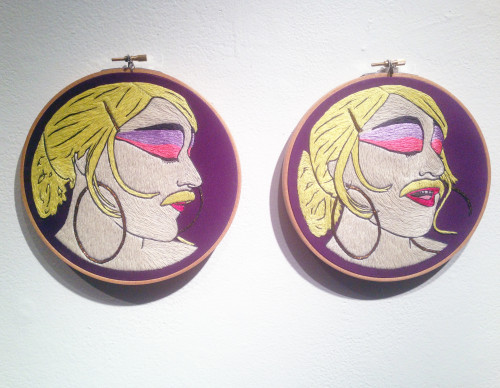
The show “Two Houses,” at the Chastain Arts Center through April 17, is an exploration into the definition of relationships, the familiar, and the delicate notion of home as sanctuary. It features the work of Jessica Caldas and Aubrey Longley-Cook, winners of the 2014 Emerging Artist Award from the Mayor’s Office of Cultural Affairs.* The artists share several other things in common: both are recipients of a 2013-14 Walthall Fellowship from WonderRoot, both produce pieces that are extremely personal in nature, and each is well-versed in expressing narrative through the use of mixed media. Their bodies’ of work correspond while maintaining their well-defined identities. Utilizing installations, various printmaking techniques, embroidery, needlepoint, drawing, projection and animation, they here question the idea of what constitutes a safe haven.
The artists view home not as the place comprising the traditional family unit, but as a pastiche of the people you meet and hold dear throughout life’s travels. Caldas provokes a visceral, emotive response in the viewer by utilizing text and language from accounts of domestic violence involving intimate partners, straight and gay. For Caldas, finding refuge in a single locale proves elusive. Even if we ourselves have not been the subject of this kind of brutality, we can attempt to understand such an experience through shared narratives and first-hand accounts found in the artists’ monotype mélanges.
Her screen prints stop you in your tracks with the force of a Soviet propaganda poster. She collages text and images to create a powerful statement about the complexity of human connections. By studying the words in the pieces you feel as if you’re right there on the frontlines of the struggle. A chord will be struck in any victim of abuse. There is a truth to Caldas’s work that is revealed through the process of overlapping the pain that stems from diverse situations. Caldas makes us feel the most through her use of the written word,whether via handwritten scrawl or excerpts from neatly typed police reports—for example, “If I had a knife I’d stab you.”

In Can’t Stop, Won’t Stop, a woman is seen being embraced by a man, both faceless. Nearby is a mug shot of another man and the line “You could have told me you were with someone else.”
In Of Age, we see a man and woman, this time in a salmon hue with the woman’s face crossed out with a white X that looks scratched into the print. A magenta clenched fist lurks in the lower right corner, while pale yellow fingerprints climb up from the bottom of the piece. In this work I found some of the most effective text:
“The petitioner is a minor, 17, and a social worker filed on her behalf. The petitioner’s mother could not take off from work to help her. The petitioner is pregnant. She moved before she could get the 12-month protective order. Her sister told the respondent where she moved too. The petitioner’s sister is friends with the respondent. The respondent confronted her at her new home and slapped and choked her. The respondent said, “If you put me in jail, my family will kill you.” Previously, the respondent had attacked the petitioner when she refused to get an abortion. The Petitioner filed a second time for a TPO. The case was abandoned after initiation. She could not attend the second hearing due to a medical appointment.”
In You, her, and the Animal, a girl is clutching her dog, holding back the happy-go-lucky pet from a possible threat. There is a strength and continuity to the repeated motifs Caldas uses: mug shots, a family smiling at a kitchen table, rope, and the image of a house. The face on the shadow of the girl is actually cut out in a jagged pattern that perhaps symbolizes a jagged personality. It is dismal to read the police report of the man hitting the woman’s dog in the head with a shovel.

The Pop art, Warhol quality of the pink, canary yellow, and deep periwinkle houses in Not What You’d Call a Home and You Can’t Change the Locks makes the prints pleasing to look at, even if the content is disturbing. An abstract splash of magenta make one house look like it’s going up in flames, while the other house stands imprisoned under jail bars. There is power in the absence of people, but you feel the humanity under crossfire, behind the closed blinds and shut doors. It’s difficult to see the image of a house and not picture a family inside; this one just isn’t seated comfortably around the dinner table. Placed side by side, the framed pieces’ power is doubled.
![Jessica Caldas, [pink and yellow] Not What You’d Call a Home and [yellow, brown, purple bars] You Can’t Change the Locks, both 2012, monotype, relief, and screen print, Photo by Sherri Caudell.](https://burnaway.org/wp-content/uploads/2014/04/Two-Houses-Installation-Shot-500x245.jpg)
Longley-Cook is immersed in the queer, the traditional, and the technological. An animation made in collaboration with participants of his RuPaul Cross Stitch Animation Workshop is made from cross-stitch frames of a clip from RuPaul’s Supermodel music video. The homespun quality is comforting in this GIF culture age. The fiery colors of some frames are mirrored by the flames engulfing the house in Caldas’s Not What You’d Call a Home. RuPaul is no hot mess—she is simply on fire.

In Longley-Cook’s Runaway installation, we see a dog galloping in a camouflaged coat of embroidered soft browns, tans, and whites. Two lit up embroidered animations guard either side of the 14 embroidery hoops that sit in between. Who is the dog running to or away from? Both Longley-Cook and Caldas use the canine as a symbol of vulnerability and innocence at different points in the exhibition.

Next is drag queen Lavonia Elberton, who only needs 9 embroidery hoops with purple backgrounds. Lavonia doesn’t look like she’s running away from anything. She looks fiercely at home. Lavonia perhaps finds a family in the needlepoint portraits of Longley-Cook’s friends from the Atlanta queen scene: Bridgette Bidet, Cayenne Rouge, Ellisourous Rex, and Xee Xee Bow Dong. These gals have most certainly found their home base.
The Longley-Cook works in this show are by now familiar from previous exhibitions; it will be nice to see what his next focus will be. Longley-Cook and Caldas both address disconnection from the familial—Caldas in a raw, painful way, Longley-Cook in a triumphant expression of the new family he has made.
A closing reception for “Two Houses” and an award ceremony for the artists will be held April 16, 6:30pm-8:00 PM at the Chastain Arts Center. The exhibition is on view through April 17. The Mayor’s Office of Cultural Affairs Emerging Artist Award, which includes a $1,500 grant, is given to artists under 35 years of age.
Sherri Caudell, a poet and writer from Atlanta, is the new poetry editor of Loose Change magazine, published by WonderRoot.




